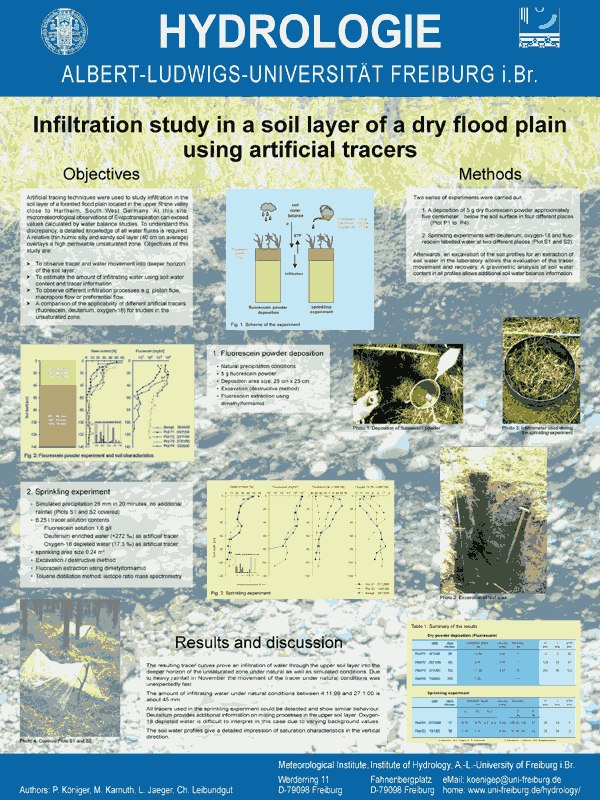Infiltration study in a soil layer of a dry flood plainusing artificial tracers
P. Königer1, M. Karnuth1, L. Jaeger2 & Ch. Leibundgut1 1University of Freiburg, Institute of Hydrology, Fahnenbergplatz, 79098 Freiburg, Germany
2Univerity of Freiburg, Meteorological Institute, Werderring 10, 79098 Freiburg, Germanye-mail: paul.koeniger@hydrology.uni-freiburg.de
Artificial tracing techniques were used to study soil layer infiltration in a forested flood plain in the upper Rhine valley near Hartheim, southwest Germany (200 m a.s.l). At this site, micrometeorological observations of evapotranspiration can exceed values calculated by water balance studies. Due to the flatness of the area there is no surface runoff. Therefore infiltration into deeper zones seems to be negligible. To prove this assumption, infiltration processes in the upper soil layer were investigated using oxygen-18 depleted, deuterium enriched and fluorescein traced water. The investigated area may be classified as almost semiarid since mean annual precipitation and temperature are 667 mm and 9.8°C respectively. River regulation work induced a lowering of the groundwater table to about 7 m below the surface. These conditions cause water stress for the pine forest during summer months. The aquifer reaches a thickness of more than 100 m and consists of quaternary fluvioglacial Rhine gravels. A relatively thin humic silty and sandy soil layer (40 cm on average) overlays a highly permeable unsaturated zone.
Two series of experiments were carried out to follow the movement of infiltrating precipitation in the upper soil layer under natural and simulated conditions: a deposition of dry fluorescein powder about 5 cm below the soil surface at four different sites, and a sprinkling experiment with deuterium, oxygen-18 and fluorescein labelled water at two different sites. Tracer movement was evaluated by excavating the soil profiles to a depth of 1.5 m and extracting soil water in the laboratory. The soil water was extracted using the toluene distillation method for isotope analysis and dimethyl-formamid for fluorescein. A gravimetric analysis of soil water content in all profiles was also done.
The resulting tracer curves in both experiments show an infiltration of water through the upper soil layer into the deeper horizon of the unsaturated zone under both natural and simulated conditions. All tracers used in the sprinkling experiment could be detected and showed similar behaviours. Due to heavy rainfall in November, the movement of the tracer under natural conditions was unexpectedly fast. The soil water profiles give a detailed illustration of vertical saturation characteristics.
The investigation of real processes, as in this study, may contribute to better understanding of the complexity of interactions in the unsaturated zone and allow more sound management of the underlying water resources in many lowland areas.
